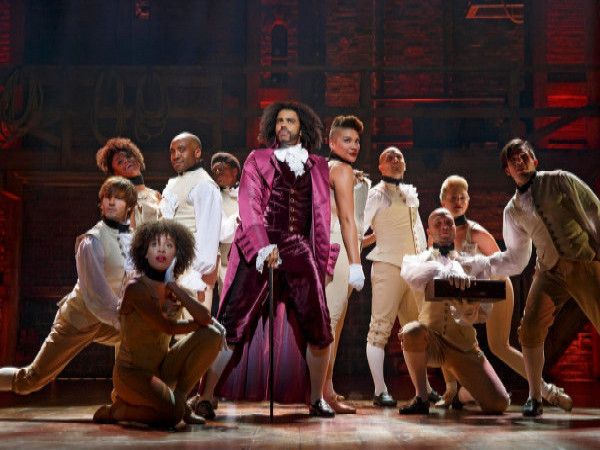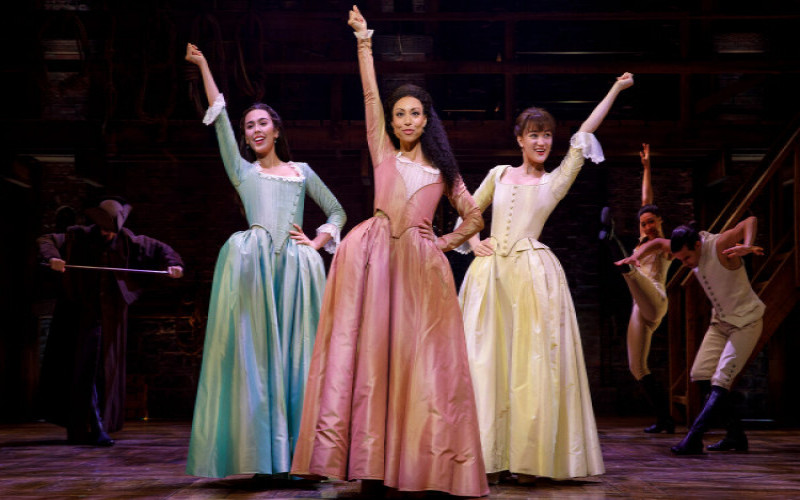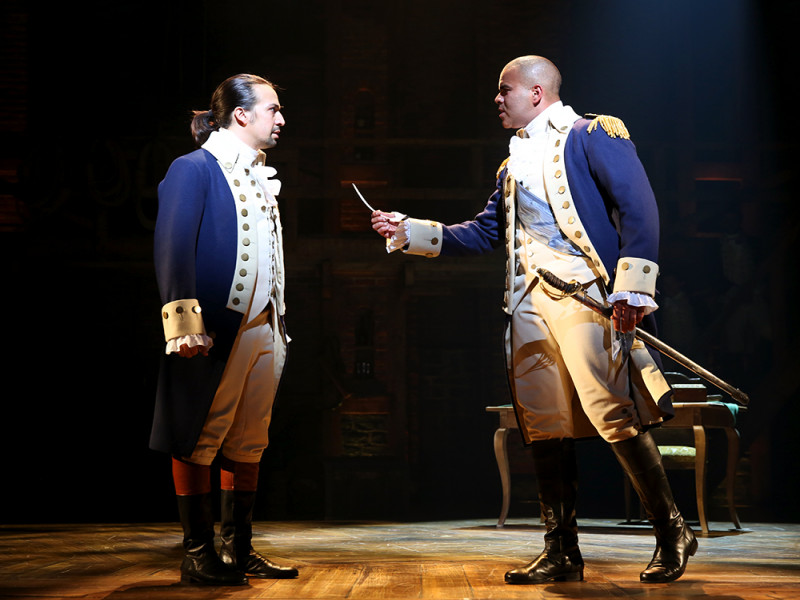Hamilton the Musical: Five Truths and Five Lies
February 14, 2022

By: Kaysey A. Richardson
I know that I’m seven years behind the trend, but I FINALLY watched Lin-Manuel Miranda’s Hamilton. If there are two things in life that I like the most, it’s musicals and history (and cats, but that’s not important right now). That being said, it’s really weird that I only just now watched a musical about history. After watching Hamilton, I had several questions and went on a deep dive into the historical accuracy of the musical. Although there are several parts of the show that are fictionalized, much of what the musical depicts really happened. So, for this blog post, I’m going to give five truths and five lies that were shown in Hamilton, and it is up to you to guess which ones are false and which ones actually happened!
In an interview with Lin-Manuel Miranda, Miranda stated that he “felt an enormous responsibility to be as historically accurate as possible, while still telling the most dramatic story possible…and when I did part from the historical record or take dramatic license, I made sure I was able to defend it…none of those choices are made lightly.” With that in mind, much of what is not historically accurate in the musical are minimal or exaggerated in order to keep the story flowing and keep the audience engaged.
Who are We?
Learn About Us Plan Your Visit
1. Hamilton was born out of wedlock as an immigrant in the West Indies before heading to America.
2. After punching the bursar and dropping out of University, Alexander Hamilton headed to New York in 1776 where he met Aaron Burr, John Laurens, Marquis de Lafayette, and Hercules Mulligan.
3. Hamilton was an outspoken abolitionist and egalitarian.
4. King George III was a little bit mad. DA-DA-DA-DA-DA
5. Eliza, Angelica, and Peggy Schuyler were well-educated sisters. The three, especially Angelica, were advocates for women’s rights but also had to uphold their status as socialites, which is why Angelica did not pursue Alexander Hamilton.
6. Following the Revolutionary War, New York City became the first capital of America.
7. Alexander Hamilton wrote a large part of Washington’s Farewell Address.
8. During John Adams’ presidency, he fired Alexander Hamilton because of their disagreements.
9.Thomas Jefferson was a confrontational and outspoken political figure and was extremely against Alexander Hamilton.
10. Following Hamilton’s death, Eliza took control of his narrative and told his story, in the process creating her own narrative and documenting her own accomplishments.
Scroll past the images to see the answers!




1. TRUE: Alexander Hamilton’s childhood and young life that was depicted in the musical was true. Alexander Hamilton was born in Charlestown, Nevis in the West Indies. His mother, Rachel Fawcett, was married to another man prior to meeting Hamilton’s father, but following her divorce the court prohibited her to remarry. Therefore, Alexander Hamilton was born out of wedlock in the Caribbean. Before becoming a teenager, both Hamilton’s mother and father passed away, leaving him as an orphan. In 1772, a hurricane devastated the West Indies, and by 1773 Hamilton began university. Only lasting a year and a half at the school, he headed to America where he began to fight for America’s freedom.
2. False: For starters, Alexander Hamilton never punched the bursar—it sounded pretty good in the song though! Additionally, Lafayette did not arrive in America from France until 1777 which is the same year that Hamilton met him and John Laurens. It is possible that Hamilton knew Hercules Mulligan earlier due to the fact that they both were at university around the same time. Also, New York City fell to British control early on in the war and Hamilton did not return to the city until after Independence. Therefore, it is impossible for Hamilton to have met any of the other figures in New York.
3. False: In the musical, Hamilton is portrayed as someone who strongly identifies with his immigrant background and outwardly opposes slavery. Unfortunately, this aspect of the narrative is not historically accurate. While Hamilton opposed slavery more than many of his colleagues, he did not outwardly express this because of the fear of a divided country. However, the best part about Hamilton is seeing such a diverse cast play historical figures. So, while Hamilton himself was complicit to slavery in real life, Lin-Manuel Miranda does not shy away from using his artistic freedom to reimagine these historical figures as people of color, making Hamilton a groundbreaking musical. By casting a diverse group of people, Hamilton successfully provides a voice to those who often do not have one and paints a picture of our diverse country: a nation whose history belongs to every American.
4. True: Well, sort of. King George was in fact mad, but the reason why is more complicated. Mental illness possibly played a part in his madness, but many historians believe that he went mad due to a debilitating metabolic condition known as porphyria: a disease that directly affects the nervous system and brain. While this disease can be treated easily today with the proper medical attention, back in the eighteenth century, doctors had no idea how to treat the King. Doctors gave him medication likely laced with poison, making his illness and “fits of madness” worse. He did not suffer from this madness until after being defeated in the American Revolution, but will remain in history as the Mad King who lost the American Colonies.
5. False: The three were socialites that were the daughters of Philip Schuyler. Philip Schuyler was a prominent general and senator in United States history,but there is no evidence that upholds the daughters being progressive and feminist. In the musical, the daughters are presented to have no other siblings when in reality, their parents had fifteen children total and eight who made it to adulthood. This included three brothers, which is different than the lyric in “Satisfied” where Angelica says her father has no sons. Additionally, Angelica and Hamilton never had a love affair prior to his wedding with Eliza. As a matter of fact, Angelica has an interesting love story of her own. When Angelica was twenty-one, she married British Politician and businessman, John Baker Church. The Schuyler’s did not approve of Church due to his involvement in suspicious activities. This led to Angelica and Church eloping and fleeing together out of America. Angelica was not even in the country when her little sister Eliza got married to Hamilton!
6.True: New York City was in fact the country’s first capital. On September 13, 1788, New York City was established as America’s first capital under the Constitution of the United States. Since 1788, New York was the host of the nation’s legislature and had been the “de facto capital.” Due to financial concerns and disagreements across the board, New York did not last long as the capital. On August 12, 1790, Congress met a final time in New York before relocating to Philadelphia and later to Washington D.C.
7. True: The song, “One Last Time” literally quotes Washington’s farewell address, which Alexander Hamilton assisted in writing! Published in 1792, George Washington’s Farewell Address was a 32-page announcement that Washington would not run for a third term as president. Additionally, he warned the United States of the rise of political parties and sectionalism, stating that these would be a threat to national unity. He also advised the young country to not form long-term alliances with other nations. Washington’s Farewell Address is still relevant today. During the Civil War, the US Senate began a tradition of reading Washington’s Farewell Address on his birthday annually.
8. False: Unlike in the musical, Alexander Hamilton resigned during George Washington’s presidency rather than being fired by John Adams. Although, it is true that Adams and Hamilton did not have a good relationship. On the contrary, John Adams was not a fan of Alexander Hamilton and oftentimes voiced his disdain toward him. At one point John Adams calls Hamilton “the brat bastard of a Scotch peddler” and in retaliation, Hamilton published a pamphlet outlining all of the reasons why John Adams should not be reelected for a second term. Hamilton’s pamphlet, along with the failed Alien and Sedition Acts that Adams signed into law in 1797, resulted in John Adams losing the election of 1800 against Thomas Jefferson by a landslide. (Side note: the election of 1800 was accurately shown in the musical, with only a few parts exaggerated!)
9. False: Personally, I wish this one was true. Daveed Diggs is the only Thomas Jefferson I want to imagine. Unfortunately, Jefferson was very opposite to how he was depicted in the musical. Rather than being eccentric and combative, Jefferson was known for his quietness, sensitivity, and careful thought when it came to political decisions. Additionally, he was not as much of an enemy of Hamilton’s as he was portrayed in the show. There were many times that Jefferson agreed and supported Hamilton and vice versa. In fact, Jefferson was a main advocate for Hamilton’s nomination for the American Philosophical Society, an organization consisting of the prolific scholars of the day. This is not to say that Hamilton and Jefferson agreed on everything; even George Washington knew the two had very different views in certain areas. Ultimately, the musical just exaggerated this aspect of history which made for a great show.
10. True: Following the death of her husband, Eliza Hamilton took it upon herself to tell the story of her husband, which also benefited her! Following the Reynolds Pamphlet, Eliza’s story was exploited without her permission. By telling Hamilton’s story after his death, Eliza was able to reclaim her own narrative as well. As a reminder, the Reynolds Pamphlet was published by Alexander Hamilton to clear his name of being involved in political corruption after being blackmailed by James Reynolds. In doing so, he admitted to his romantic involvement with James’ wife, Maria, and thus humiliating Eliza in the process. Another truth to the musical is the depiction of Eliza burning love letters between her and Hamilton, though it cannot be known for certain her reasoning behind this. Finally, in the last song of the musical, Eliza sings of her philanthropy that she became involved in after Hamilton’s death. This was also true! Eliza founded The Hamilton Free School which was the first school in Washington Heights and became heavily involved in helping orphans and widows.
References and Further Readings:
https://screenrant.com/hamilton-historical-inaccuracies-wrong-true-story
https://www.refinery29.com/en-us/2020/07/9894557/hamilton-musical-real-history-facts
https://www.hamiltonburr.org/characters/john-adams/
https://www.senate.gov/artandhistory/history/minute/Washingtons_Farewell_Address.htm
https://www.americanyawp.com/reader/a-new-nation/george-washington-farewell-address-1796/